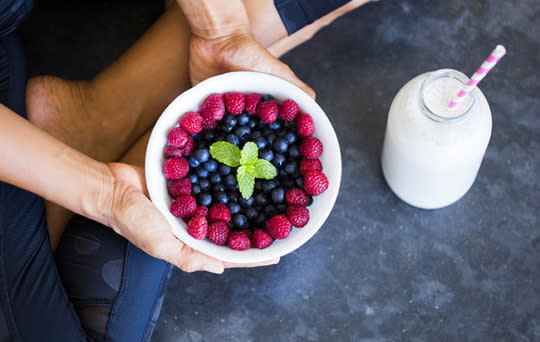How a Nutritionist Decides if a Snack Is Good for You

It’s not just about calories and sugar. (Photograph: Shutterstock)
When 3 p.m. hits, that pack of Reese’s in the vending machine look so much more appealing than carrot sticks and hummus. But what if we were to tell you that the carrot sticks might not actually be your best bet? We spoke with Jess Scott, the nutritionist who works with the good-for-you snack-subscription service Graze, to find out how she determines if a snack is healthy…and her three main litmus test questions might surprise you.
1. Will It Fill You Up?
The key words here are protein and fiber. “These will keep your energy levels on an even keel and give you that long supply of energy, rather than quick burst,” says Scott. Ideally, you want around 10 grams of protein and six to 10 grams of fiber in your snacks.
2. Is It Minimally Processed?
Scott’s big go-tos—whether she’s choosing snacks on her own or making recommendations for Graze—are nuts and seeds; she knows they’re nutrient-dense and that they’re filled with healthy fats (which will also help keep you satiated). But even if you don’t feel like reaching for some almonds, going with foods that haven’t been processed to death is definitely the way to go. “As soon as processing gets involved, then as a result of the heating or the human intervention, it tends to deplete the nutrients because vitamins and nutrients are very fragile,” says Scott. “That’s why raw foods are really great because all the nutrients that naturally appear in the food still remain in there.”
3. Do You Actually Like It?
Snacking isn’t just about filling up on veggies and other whole foods. “Enjoyment is a huge thing when it comes to snacking,” says Scott, who explains that you don’t have to rely on willpower to keep yourself from eating the foods you really love if you’re already eating foods you really love (albeit nutritious ones).
…But What About Calorie Counts?
Scott says to forget about them. “I’m really trying to educate people you’re not looking at calories as the barometer for health because you could have 200 calories of white chocolate or something that doesn’t contain any nutrients whatsoever and compare that to 200 calories of coconut,” she says. “In the body, it’s going to have a totally different role and effect.” Instead, she recommends going off of your hunger and fullness cues. “The likelihood of your overeating is low if you eat mindfully and have foods full of nutrition,” she says.
More from Women’s Health:
What Nutritionists Eat for Every Kind of Ailment
The Exact Formula for a Weight-Loss Boosting Breakfast
